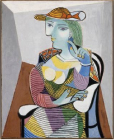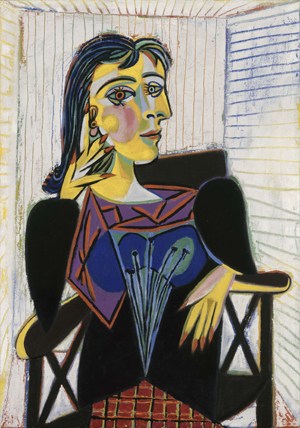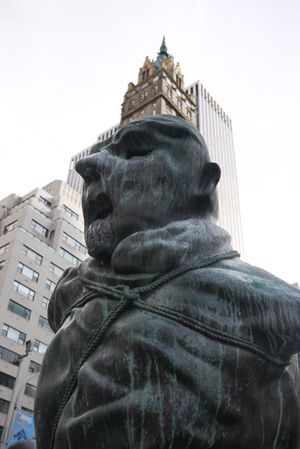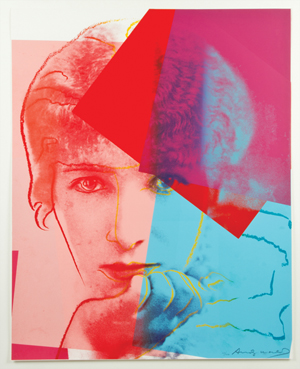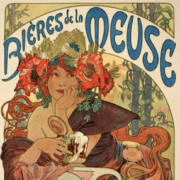Paris exhibit celebrates ‘first celebrity’ Sarah Bernhardt
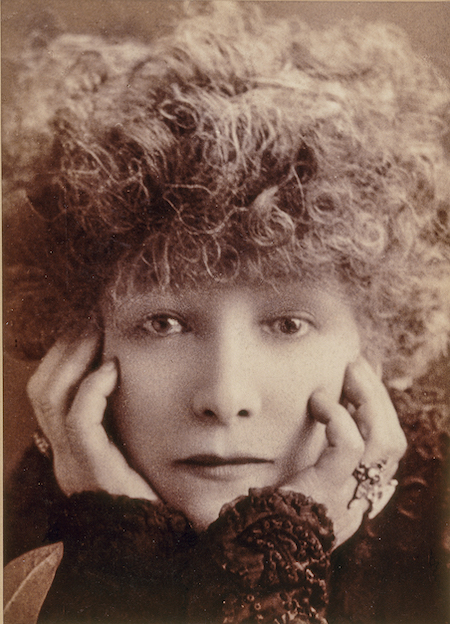
William Downey, ‘Sarah Bernhardt close-up,’ photography, BNF, Department of Performing Arts. © BnF. Photo credit Paris Musees / Petit Palais / Gautier Deblonde
PARIS (AP) – The pioneering French stage star Sarah Bernhardt was one of the world’s most famous women by the time of her death in 1923 – a status she owed not just to acting talent but her modern instinct for self-publicizing and using the press to brand her image. A century later, the Petit Palais museum in Paris has opened an exhibit on the eccentric, scandalous and multi-hyphenate performer known as “La Divine,” whom many consider the world’s first celebrity. Sarah Bernhardt: And the woman created the star runs until Aug. 27.
At the Paris museum, the public is now discovering the madcap jigsaw puzzle of Gothic stories, costumes, recordings, films, photos, jewels, sculptures and personal objects, shown for the first time together, which made Bernhardt an object of fascination from Berlin to London and New York.
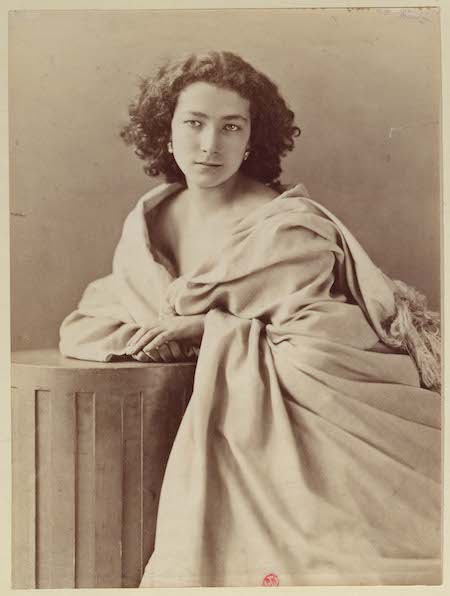
Felix Nadar, ‘Sarah Bernhardt draped in white,’ around 1864.
Albumen print from a collodion glass negative 22.9 by 17.9cm. With frame: 43 by 33cm. BNF, Department of Prints and Photography. Paris, France. © BnF. Photo credit Paris Musees / Petit Palais / Gautier Deblonde
“Sarah Bernhardt was more than a famous actress. She was one of the first celebrities. She was a businesswoman, a fashion icon, a sculptor, theater director, a visionary, a courtesan. She pushed gender boundaries. By self-publicizing, she paved the way for many, including Marilyn Monroe, Greta Garbo, Madonna, Lady Gaga and Beyonce,” said Stephanie Cantarutti, curator of the exhibit Sarah Bernhardt: And the woman created the star.
The show marking the centenary of her death brings together around 400 artworks, photographs, objects and other items that delve well beyond her life on stage.
It starts at the dawn of her career: A handwritten log in the official Parisian Register of Courtesans from the 1860s with a photograph of her and descriptions of the activities of this young “courtesan.” Bernhardt was, after all, born into her life’s first role: her mother was also a courtesan, and the mistress of Napoleon III’s half-brother.

Left, Napoleon Sarony, ‘Sarah Bernhardt in ‘Cleopatre,’ 1891. Proof on albumen paper. 9.2 by 15.8cm. Mounting: 10.9 by 16.6cm. Musee d’Orsay. Paris, France. Photo © RMN-Grand Palais (Orsay Museum) / Herve Lewandowski; Right, Anonymous, pectoral necklace for Cleopatra, 1890. Costume and accessory, 60 by 43cm. National Library of France, Performing Arts Department. © BnF. Photo credit for both: Paris Musees / Petit Palais / Gautier Deblonde
The exhibit snakes loosely through the chronology of her life: from her beginnings on stage after Alexandre Dumas took her to the Comedie Francaise, to her most famous roles such as Joan of Arc, Phaedra and Cleopatra – showcasing the dazzling costumes worn at the Theater Sarah Bernhardt that were for Americans then an emblem of Paris at the dawn of the modern fashion industry. The Theater Sarah Bernhardt at Chatelet has since been renamed the Theater de la Ville, while all that remains in the building bearing her name is a cafe-restaurant.
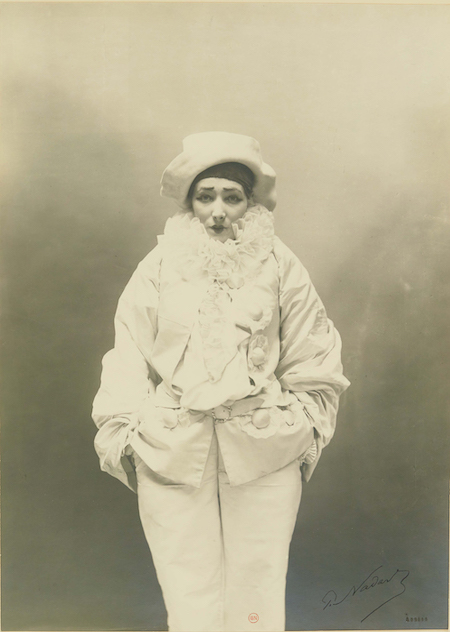
Paul Nadar, ‘Sarah Bernhardt in Pierrot assassin,’ 1883, silver print. BNF, Department of Prints and Photography Paris, France. © BnF. Photo credit Paris Musees / Petit Palais / Gautier Deblonde
She was one of France’s most prolific gender-benders, famously quoted as saying that she needed to play male characters to feel less restricted. A photo in the exhibit shows Bernhardt in men’s costume, playing Hamlet in a French version of the play.
“She said that roles given to women were not interesting enough and she could not demonstrate all of her talent playing them, so she played many male roles. She was ahead of her time,” Cantarutti said, adding that Bernhardt was bisexual and was often photographed wearing pants – when it was illegal for a woman to do so – decades before stars such as Marlene Dietrich.

Left, Alphonse Mucha, ‘Gismonda,’ 1894. Color lithograph, 210 by 72cm. National Library of France, Performing Arts Department © BnF; Right, Alphonse Mucha, ‘The Lady of the Camellias, Renaissance Theatre,’ 1896. Color lithograph, 32.8 by 14.1cm. © Paris Museums / Carnavalet Museum – History of Paris. Photo credit for both: Paris Musees / Petit Palais / Gautier Deblonde.
She was an early influencer, dazzling Oscar Wilde, who wrote the play Salome in French for her and called her “the incomparable one.” She inspired Marcel Proust. She was visited in her dressing room by Gustave Flaubert, while Mark Twain wrote: “There are five kinds of actresses: bad actresses, fair actresses, good actresses, great actresses, and Sarah Bernhardt.”
Her intuition for using emerging media and staging stories for the press was key to the actress’ particular mystique.
She made a name for herself during the Universal Exhibition of 1878, escaping in a hot air balloon over the Tuileries garden, where she sliced the neck off a bottle of champagne with a sword and tasted foie gras, she said, to escape the bad smell of Paris.
Not all was rosy – she suffered from having one lung, one kidney and later in life only one leg, but was never downtrodden.
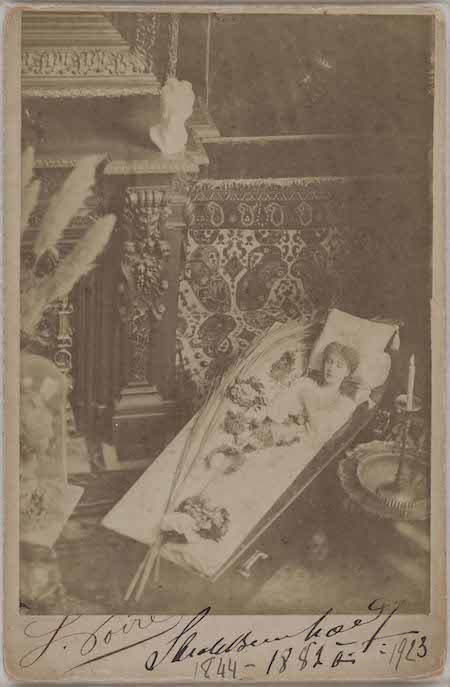
Melandri, ‘Sarah Bernhardt sleeping in her coffin,’ circa 1880. City of Paris / Marguerite Durand Library. © City of Paris / Marguerite Durand Library. Photo credit Paris Musees / Petit Palais / Gautier Deblonde
Because of her penchant for tragic roles, rumors spread that Bernhardt slept in a coffin at night. She saw the potential of playing to the gossip: She paid for a padded coffin to be installed in her home and hired a photographer to snap her sleeping in it.
“That photo went everywhere; it became very famous. She also had a hat made of bats,” Cantarutti said.
The Gothic then became her brand when she acquired a pet baby alligator at home, whom she named Ali Gaga. Ali Gaga died of liver failure because Bernhardt nourished it only on champagne, according to Cantarutti.

Left, Paul Boyer, ‘Sarah Bernhardt in Theodora by Victorien Sardou,’ 1902 gelatin silver bromide print, © Bibliotheque historique de la Ville de Paris, Roger-Viollet; Center, Theophile Thomas, stage coat by Sarah Bernhardt for Theodora, 1884, fabric embroidered with silk thread, glass beads, Paris © BnF; Right, Anonymous, headdress for Theodora, circa 1884, copper alloy, colored glass cabochons, Palais Galliera, Paris Fashion Museum, © Paris Musees / Palais Galliera-Paris Fashion Museum, Paris © BnF. Photo credits for all three images Paris Musees / Petit Palais / Gautier Deblonde
Bernhardt later went on to take the United States by storm. She was greeted as a celebrity there during her 1912-13 American tour, even though few could understand anything from her French-language performances.
The tour was hot off the heels of the success of her groundbreaking 1912 silent movie Queen Elizabeth. The man who secured the U.S. rights to broadcast it during her tour, Adolph Zukor, became so rich that he used the profits from the film to found the Paramount Pictures movie studio – then the Famous Players Film company – according to the museum.
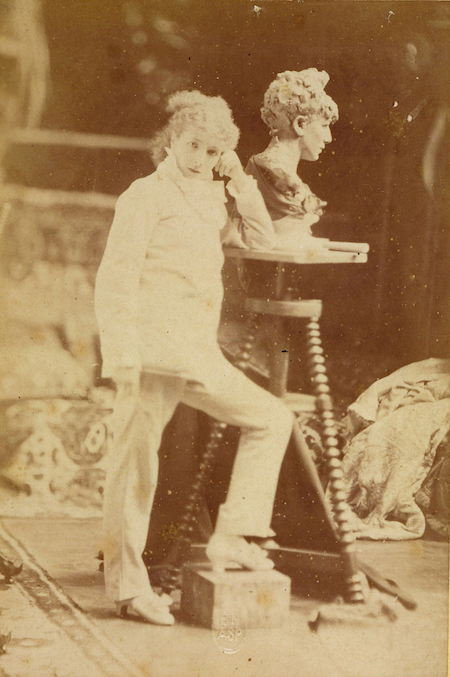
Achille Melandri, ‘Sarah Bernhardt sculptor.’ Photography Woodburytype, 11.8 by 8, 30 by 24 (marie louise). © BnF, Dist. RMN-Grand Palais / BnF image. Photo credit Paris Musees / Petit Palais / Gautier Deblonde
Yet it was sculpture that was her inexhaustible life’s great passion, spawning remarkable works in marble and bronze – some of which were feted and shown at the Universal Exhibition of 1900. Several of her sculptures are permanently shown at the Musee d’Orsay in Paris.
“It seemed to me now that I was born to be a sculptor and I had begun to see my theater in an ill light,” Bernhardt said in her autobiography My Double Life.

Georges Clairin, ‘Sarah Bernhardt in her garden at Belle-Ile-en-mer.’ 1919, oil on canvas, 80 by 155cm. © Tours Museum of Fine Arts, photo Dominique Couineau, Photo credit Paris Musees / Petit Palais / Gautier Deblonde
“Despite it all” was her mantra and the phrase she identified with, the exhibit says.
“Despite the difficulties in her life, starting as a courtesan, trying to break out in a man’s world. Despite all that, and then being an amputee, she continued on,” Cantarutti said.
By THOMAS ADAMSON, Associated Press
Copyright 2023 Associated Press. All rights reserved. This information may not be published, broadcast, rewritten, or redistributed.


